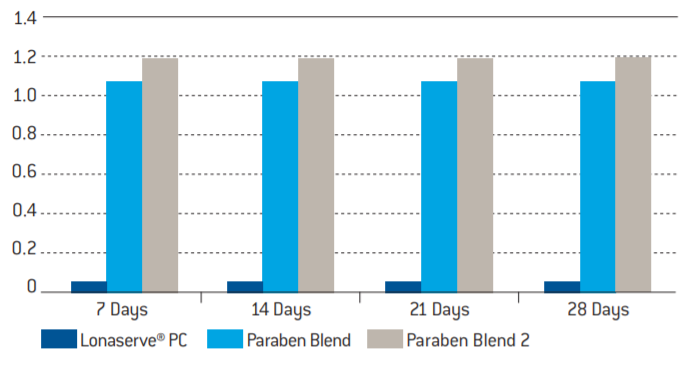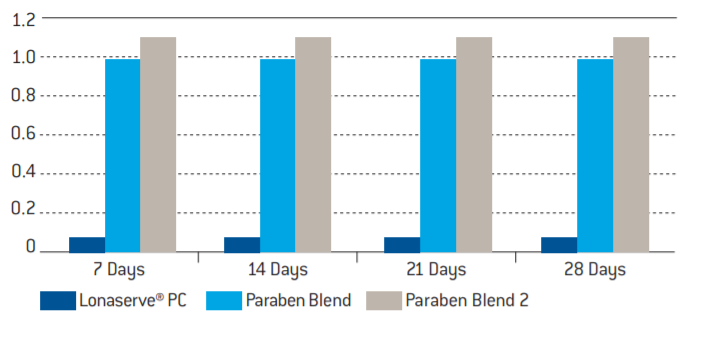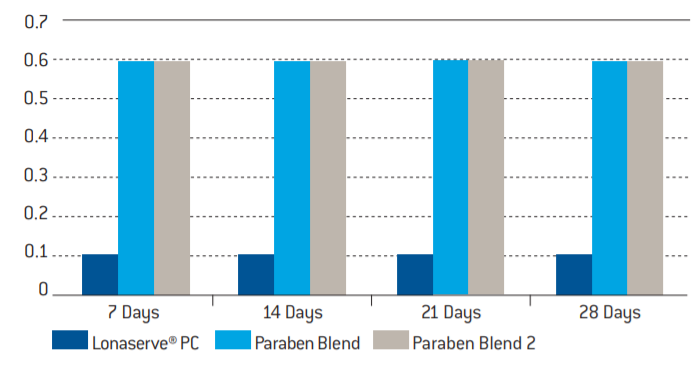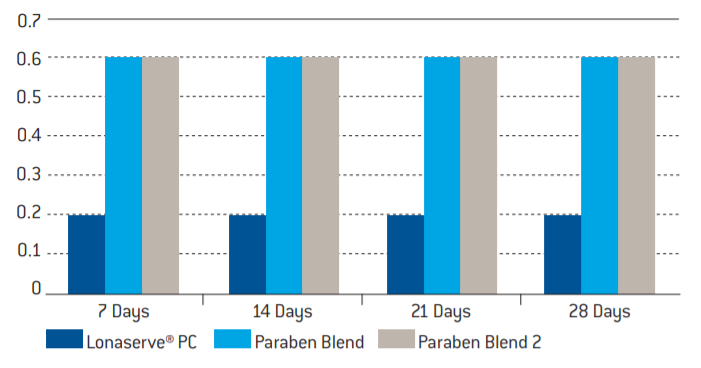Enhanced TDS
Knowde-enriched technical product data sheet
Identification & Functionality
- INCI Name
- Cosmetic Ingredients Functions
- Technologies
- Product Families
- Compositional Breakdown
Chemical Compound Breakdown CAS No. EINECS No. DMDM Hydantoin 6440-58-0 229-222-8 Methylchloroisothiazolinone 26172-55-4 247-500-7 Methylisothiazolinone 2682-20-4 220-239-6 Water 7732-18-5 231-791-2 Chemical Compound Breakdown % DMDM Hydantoin 71% Methyl chloroisothiazolinone 0.04% Methylisothiazolinone 0.01% QS water 28.95%
Features & Benefits
- Benefit Claims
- Labeling Claims
- Key Attributes
- Stable, synergistic, patented blend
- Colorless liquid preservative
- Low isothiazolinone levels in end products (< 1 ppm)
- Ultra-low free formaldehyde (< 0.09 %)
- Safe toxicology profile
- Broad spectrum efficacy
- Neutral pH
- Effective against formaldehyde and isothiazolinone resistant organisms
- Color stability
- Compatible with cationic, anionic, nonionic systems
- Ease of handling
- Compatible and soluble in virtually all raw materials
- Aqueous, non-freezing blend
Applications & Uses
- Markets
- Applications
- Application Format
- AP/Deo Applications
- Bath & Shower Applications
- Color Cosmetic Applications
- Hair Care Applications
- Personal Hygiene Applications
- Skin Care Applications
- Sun Care Applications
- Wipes, Tissue & Towel Applications
- Use Level
- 0.05 – 0.2 %
- Application pH Range
- 3–9
- Applications
- Anhydrous
- Body wash
- Conditioner
- Cream
- Deo/Anti-Perspirant
- Eye creams/gels
- Eye shadow
- Face lotion
- Face wipes
- Facial cream
- Foundation
- Hair gel
- Hand soap (non anti-bac)
- Lotion
- Makeup remover
- Mascara
- Oil in Water
- Powder
- Shampoo
- Sun Care
- Toner
- Water in Oil
- Formulation Recommendations
- Readily soluble in aqueous phase, as well as in polar organic solvents
- Reducing agents, amines and strong nucleophiles will reduce activity of MCI/MI
- When used with amines, pH should be below 6 before addition
- Surfactants should be checked for residual bisulfite before addition
- Should be added during the cool down phase of processing, at temperature of 50°C or below
- pH: 3–9
Properties
- Physical Form
- Odor
- Mild
- Soluble in
- Water
Regulatory & Compliance
- Certifications & Compliance
- Chemical Inventories
- Global Regulatory
Europe
- Not permitted for leave-on products. Maximum use level of 0.0015 % CMI/MI for rinse-off applications
Japan
- Max use level of 0.3 % DMDMH and 0.01 % CMI/MI for rinse-off
- Not permitted for leave-on due to CMI/MI
US
- Max use level of 0.6 % DMDMH and 0.00075 % CMI/MI for leave-on
- Max use level of 0.6 % DMDMH and 0.0015 % CMI/MI for rinse-off
Technical Details & Test Data
- Efficacy
Studies were run using different concentrations of Lonzaserve® PC in various formulations to see efficacy against various bacteria, yeast and fungi. All samples were inoculated at the beginning of the study, sampled at 7, 14, 21 and 28 days.
- Anionic Protein Shampoo
pH: 7
Ingredient %W/W Sterile DI Water 36.0 % Sodium Lauryl Ether Sulfate 35.0% Triethanolamine Lauryl Sulfate 25.0% Coco Diethanolamine 3.0% Anhydrous Protein 1.0% Total 100.00% - Test Results
Percent of Lonzaserve® PC required to achieve < 10 cfu/g of mixed bacteria in anionic shampoo

Percent of Lonzaserve® PC required to achieve < 10 cfu/g of mixed fungi in anionic shampoo

- Non-Ionic Cream
pH: 6
Ingredient %W/W Aldosperse® 4.0% Aldo® MSC 6.0% Cetearyl Alcohol 1.5% Lonzest® 143-S 8.0% Glycon G 5.0% Water Q.S. Total 100.00% - Test Results
Percent of Lonzaserve® PC required to achieve < 10 cfu/g of mixed bacteria in a nonionic cream

Percent of Lonzaserve® PC required to achieve < 10 cfu/g of mixed fungi in a nonionic cream

Packaging & Availability
- Country Availability
- Regional Availability